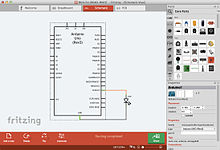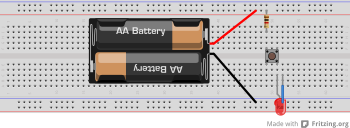Fritzing: Difference between revisions
No edit summary Tags: Mobile edit Mobile web edit |
m Dating maintenance tags: {{Advert}} |
||
| Line 1: | Line 1: | ||
{{advert}} |
{{advert|date=March 2022}} |
||
{{Short description|Open source CAD syatem for electronic design, aimed at hobbyists}} |
{{Short description|Open source CAD syatem for electronic design, aimed at hobbyists}} |
||
{{Infobox software |
{{Infobox software |
||
Revision as of 01:01, 21 March 2022
This article contains promotional content. (March 2022) |
 Fritzing's breadboard view | |
| Developer(s) | Interaction Design Lab Potsdam |
|---|---|
| Stable release | 1.0.4[1] |
| Repository | |
| Operating system | Mac OS X, Unix, Windows |
| Type | EDA |
| License | GPL 3.0 or later (software) CC BY-SA 3.0 (component images)[2] |
| Website | fritzing |
Fritzing is an open-source initiative[3] to develop amateur or hobby CAD software for the design of electronics hardware, to support designers and artists ready to move from experimenting with a prototype to building a more permanent circuit. It was developed at the University of Applied Sciences Potsdam.[4] Fritzing is free software under the GPL 3.0 or later license, with the source code available gratis on GitHub and the binaries at a monetary cost, which is allowed by the GPL.[5]
Goals

The software is created in the spirit of the Processing programming language and the Arduino microcontroller[6] and allows a designer, artist, researcher, or hobbyist to document their Arduino-based prototype and create a PCB layout for manufacturing. The associated website helps users share and discuss drafts and experiences as well as to reduce manufacturing costs.
Fritzing can be seen as an electronic design automation (EDA) tool for non-engineers: the input metaphor is inspired by the environment of designers (the breadboard-based prototype), while the output is focused on accessible means of production. As of December 2, 2014 Fritzing has made a code view option, where one can modify code and upload it directly to an Arduino device.[7]
Component images are distributed under CC BY-SA 3.0, which will also be the license for any generated breadboard views.
 |
 |
Developer
The Fritzing source code is written in C++ using the Qt-framework. The source code can be downloaded and edited via the GitHub repositories. The source is split in two main repositories: Fritzing-App and Fritzing-Parts.
Maker
Fritzing allows for easy creation of printed circuit boards. FritzingFab enables users to order PCBs with designs made on the Fritzing software.
See also
- Comparison of EDA software
- List of free and open source software packages
- List of free electronics circuit simulators
References
- ^ https://blog.fritzing.org/2024/10/08/fritzing-1-0-4.
{{cite web}}: Missing or empty|title=(help) - ^ What license is Fritzing released under? FAQ
- ^ McRoberts, Michael (2010). Beginning Arduino. APress. pp. xx. ISBN 978-1-4302-3240-7.
- ^ Brühlmann, Thomas (2010). Arduino: Praxiseinstieg. Hüthig Jehle Rehm. p. 270. ISBN 978-3-8266-5605-7.
- ^ "Frequently Asked Questions about the GNU Licenses".
- ^ Gläser, Thomas; Markus Jaritz; Philipp Sackl (13 September 2009). "Hardware-Hacking: So baut man einen Tentakel-Roboter für 100 Euro". Der Spiegel. Retrieved 14 April 2011.
- ^ http://blog.fritzing.org/2014/12/02/its-fritzmas-new-fritzing-code-view-release-and-a-little-present. [dead link]
External links
- Official website
- User Forum
- FabService
- Fritzing-App on GitHub
- Fritzing-Parts on GitHub
- Fritzing overview
